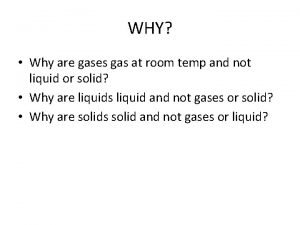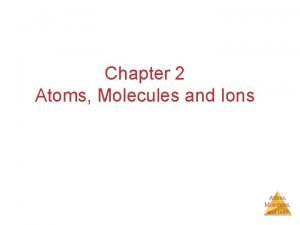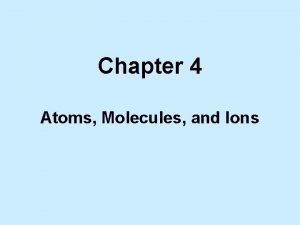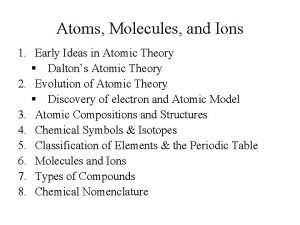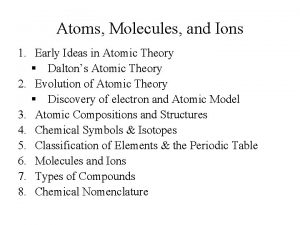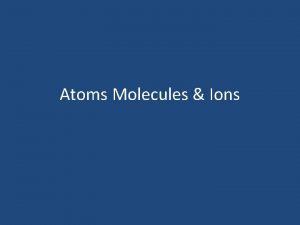2 Atoms molecules ions 2 1 Early ideas









- Slides: 9

2. Atoms, molecules & ions 2. 1: Early ideas about atomic theory • State the postulates of Dalton’s atomic theory • Use postulates of Dalton’s atomic theory to explain the laws of definite & multiple proportions

Atomic theory up to the 19 th century 5 th century BC, Greek philosophers Leucippus & Democritus argued that all matter was composed of small, indivisible particles called atomos, Greek for indivisible. This idea was discarded as Aristotle, 4 th century Greek, held that matter was composed of different proportions of the four ‘elements’, earth, wind, fire & water. www. new-physics. com

Dalton’s atomic theory 1806, English school teacher John Dalton used experiments to revive the ancient concept of a universal element of matter & proved the existence of the atom. 1. Matter is composed of tiny particles called atoms: smallest unit of an element that can participate in chemical change. 2. Every element is made of one type of atom with a characteristic mass. All atoms of one element are identical. 3. The atoms of each element different & found only in that element. 4. A compound is made by combining atoms of two or more elements at a constant, whole-number ratio. 5. Chemical reactions neither create nor destroy atoms, but rearrange them to create new substances.

Visualize a chemical reaction Chemistry Openstax

Obeying Dalton’s postulates? Do the chemical reactions shown here obey the five postulates of Dalton’s atomic theory? If not, why? 1 Nope. Matter is not conserved as the product is missing two atoms, one blue, one green. Yes! Matter is conserved here. Chemistry Openstax

Law of definite proportions Aka Law of constant composition: all samples of one compound have the same elements in the same proportion by mass, or the same atomic ratio sample* carbon (g) hydrogen (g) mass ratio (C : H) A 14. 82 2. 78 5. 33 : 1. 00 B 22. 33 4. 19 5. 33 : 1. 00 C 19. 40 3. 64 5. 33 : 1. 00 *isooctane, C 8 H 18 Dalton knew of this work done by the French chemist Joseph Proust.

Law of multiple proportions: two elements can be combined in a number of different proportions or ratios to create a number of different compounds • Multiple proportions produce multiple compounds Cu : Cl 1. 0 g : 0. 558 g Cu : Cl 1. 0 g : 1. 116 g Here Dalton riffed on Proust’s work, adding his own experiments. Chemistry Openstax

Try this Compounds A & B are both clear & odorless gases. A sample of compound A is found to contain 4. 27 g of C and 5. 69 g of O. A sample of compound B is found to have 5. 19 g of C and 13. 84 g of O. Are A & B examples of the law of definite proportions, the law of multiple proportions, or neither? 2 A 5. 69 g O = 1. 33 g O 4. 27 g C 1. 00 g C B 13. 84 g O = 2. 67 g O 5. 19 g C 1. 00 g C A & B illustrate the law of multiple proportions.

Can you? (1) State all the postulates of Dalton’s atomic theory? (2) State the law of definite proportions describe how it relates to molecular formulas? (3) Explain the law of multiple proportions & give an example?
 Chapter 2 atoms molecules and ions
Chapter 2 atoms molecules and ions Atoms molecules and ions
Atoms molecules and ions Atoms ions and molecules
Atoms ions and molecules Atoms molecules and ions
Atoms molecules and ions Atoms ions and molecules
Atoms ions and molecules Atoms molecules and ions
Atoms molecules and ions States that atoms ions and molecules must collide to react
States that atoms ions and molecules must collide to react Atoms molecules and ions
Atoms molecules and ions What do the roman numerals in a cation's name indicate
What do the roman numerals in a cation's name indicate Interacting molecules or ions
Interacting molecules or ions









